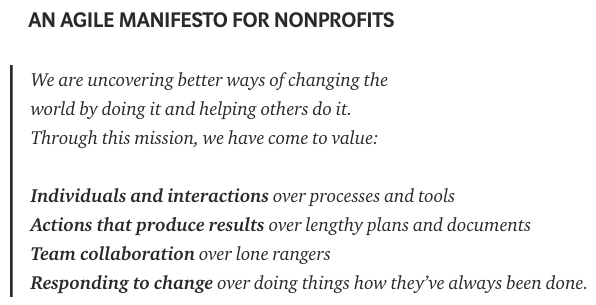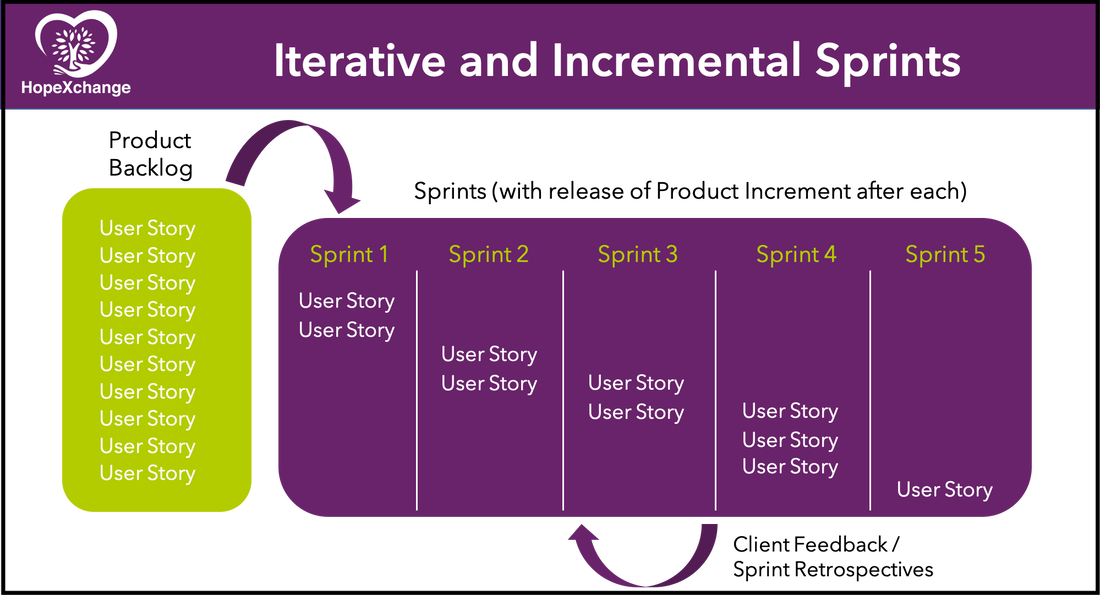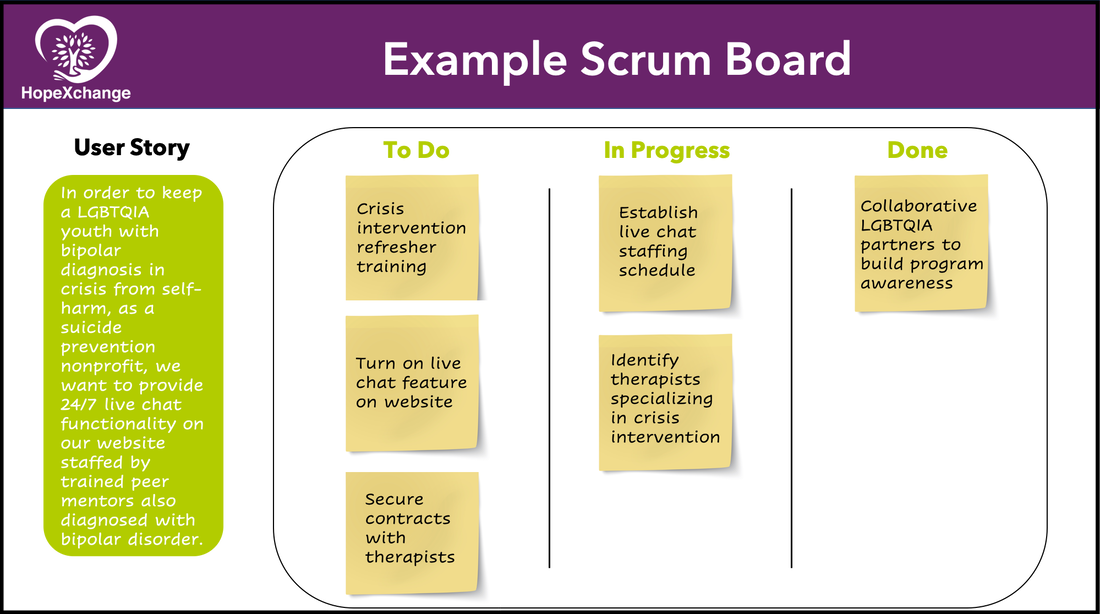|
4/1/2020 Saving Lives Using Scrum: How to maximize social impact and minimize fundraising stress.Read NowAgile dates back to 2001 and has its roots in software development. A team of 17 leaders came together to write what has become known as the Agile Manifesto. Why are so many organizations across a vast array of industries now adopting Agile? Look no further than the 13th Annual State of Agile Report for the many benefits companies are reaping, including a 63% increase in delivery speed / time to market, 64% increase in team morale and 52% reduction in product risk. Ben Battaglia in his post, Why Nonprofit Teams Need Agile, shares a similar version of the original Manifesto but modified for nonprofits (as well as shares a convincing case for why NPOs should adopt Scrum). While there is value in the four items on the right, the bolded items on the left are valued more. Forward-thinking NPOs are now starting to depend on Agile practices to maximize the impact of limited resources and to stay flexible and innovative with both program and fundraising initiatives. Scrum is the most widely-used framework to put these Agile values into practice, with 72% of respondents to the 13th State of the Agile survey practicing Scrum (or a hybrid). It derives its name from the game of rugby and refers to the way a team comes together to move a ball down the field. As Sutherland states, in Scrum, “careful alignment, unity of purpose, and clarity of goal come together.” Would your nonprofit leadership seize the opportunity to achieve its mission faster and create an even greater impact faster? If the answer is yes, I highly recommend this free webinar, Why Use Scrum: How to Double the Outcomes of Your Nonprofit in Half the Time, hosted by Avi Schneier, Scrum, Inc. and Diane H. Leonard, Agile in Nonprofits. And, rather than get into a lengthy explanation of how Scrum work, I will show you by how we would have leveraged this approach to launch our HOPE for LGBTQIA program. Hope Time MachineI invite you to go back in time with me in the “Hope Time Machine.” On this journey, I will illustrate how this program could have seen the light of day and pulled gay youth out of the darkness. (Note: our website has been temporarily republished on a different free domain name for the purposes of this retrospective article and will be taken off-line shortly. Please excuse any broken links, particularly those related to donations). Hope Xchange was the only nonprofit dedicated to preventing suicide and improving mental health outcomes in the bipolar community. Next year, more than 50,000 Americans will die of suicide. Half of them will have bipolar disorder. As the only “front-line” organization, our mission was focused primarily on directly helping those affected through 1:1 interactions, mentorship, and mental health advocacy. In Demi Lovato’s latest release, Anyone, she asks why no one listened. At Hope Xchange, we listened. But then we heard a loud call to action from a most vulnerable, totally under-served population at the highest-risk for suicide: LGBTQIA youth diagnosed with bipolar disorder. And, after doing our homework, we knew that our current programs were not the complete solution. We sorted out what would work and it was a big program with a big price tag which would require a big team effort and a big fundraising push. Based on our research and peer-mentoring experience, this first-of-its-kind virtual password-protected safe space needed:
So, where did we go wrong? We thought we had set ourselves up for success. We brought in a dedicated, volunteer project manager as we knew we needed to focus, one of the five Scrum values. (Our team already lived the other four Scrum values: courage, commitment, openness and respect). We had a volunteer development team in place, our website platform had built-in chat and password-protected member functionality, we used Volunteer Match with tremendous success to recruit the most kind-hearted, compassionate and well-qualified peer mentors as well as an extremely talented marketing and communications team for social media, online fundraising, etc. We also had secured a rock-solid plan from a third-party vendor to build the mobile app with our desired geo-locate functionality. But, then we made what would prove to be a crucial misstep. Despite an inordinate amount of heart-driven effort that I am so incredibly proud our team put forth, we used the traditional waterfall project management method. Sometimes such detailed project plans set unrealistic expectations, goals and deadlines and, in Sutherland’s prophetic words, are “always always wrong.” Instead of moving the ball down the field, play-by-play, we went for the touchdown. Not only did we lose the game, we lost our way. Our team’s morale took the nose dive of all nose dives, our fundraising goal was far too unrealistic, and the worst part, our potentially life-saving program did not see the light of day. It drove Hope Xchange right into the ground. But, more importantly, how could we have gotten it right? Rather than fundraise to build the entire solution — and risk everything on that effort succeeding — we could have leveraged Scrum, building one iterative program increment at a time in five back-to-back, two-week sprints with five consecutive and more realistic fundraising drives to support each Sprint goal. Time-boxed Sprints, never more than one-calendar month (but, in our case, two weeks would have been sufficient), force delivering incremental “done” products early and often so those you are trying to help do not suffer needlessly by waiting. Unlike traditional waterfall project management, this approach also has built-in realism: defined events and transparent artifacts to focus enthusiasm, ground expectations, minimize risk and enable critical inspect and adapt cycles. Built into these iterative cycles are critical opportunities for client feedback so the program can be tailored to give end users exactly what they most want and need, as well as opportunities to collect user testimonials along the way that can then be leveraged in smaller, incremental fundraising drives that are more realistic and attainable. The product backlog lists the higher-priority (value) items as User Stories, with a realistic number tackled in each Sprint contingent on the capacity of the team. User Stories can be written from the perspective of the internal stakeholder (in this case, Hope Xchange) or the external stakeholder (gay youth diagnosed with bipolar disorder). An example user story for each follows. [Internal Stakeholder] User Story: Access to Live Chat In order to keep a LGBTQIA youth with a bipolar diagnosis in crisis from self-harm, as a suicide-prevention nonprofit we want to provide 24/7 live chat functionality on our website staffed by trained peer mentors, with an option to dial in a crisis-intervention therapist. [External Stakeholder] User Story: Password-Protected Social Network As atransitioning 16-year old being bullied at school and recently diagnosed with bipolar disorder, I want an online space where I can feel safe and accepted. An illustrative, albeit oversimplified, Scrum Board shifting the Internal Stakeholder User Story, Access to Live Chat, into the Sprint Backlog follows: Hope Xchange Paid Dearly. Looking Into Agile/Scrum Will Cost You Nothing.We were a small yet nimble, volunteer-driven nonprofit that had managed to build a national reputation, even garnering the attention of the FDA with a Patient and Caregiver Listening Session. Our team was chock full of passionate sprinters. We could have been sprinting away, releasing incrementally “done” functionality. And, most importantly, those in urgent need of help could have been receiving it and a life could possibly have been saved. All we needed was a change in approach (Agile/Scrum), white board and sticky notes. In other words, we had all the bits and pieces to pull this off. We had the requisite foundation but we opted to go for a traditional waterfall project management approach to put all the walls up at once and one huge fundraising push to pay for this large build. We could have built incrementally and paid for one room at a time. And, we paid dearly. Our doors are now closed. Please look into Agile and Scrum. This, my friends, will cost you nothing. In the second part of this series, I’ll discuss how you can implement Agile/Scrum in your nonprofit using a bottoms-up, incremental approach to demonstrate its business value (i.e., to sell it in-house and to your Board) and how it truly can make a dramatic difference. For information on why a program like HOPE for LGBTQIA is still urgently needed and how we can help gay youth with bipolar disorder at the highest risk for suicide, please see the Addendum below. ADDENDUM: How Do We Give Gay Youth with Bipolar Disorder at the Highest Risk for Suicide a Reason to Stay?Hope Xchange’s video below, while perhaps hard to watch, depicts reality for our gay youth today. We simply must give them a reason to stay. If not now, when? Building a virtual safe space where gay youth who are struggling can log into a password-protected site via a Mobile app/tablet/laptop and interact with their own community who are experiencing the same struggles can not only empower them but also lift their peers up. In such an accepting and safe environment, they may also be more willing to reach out for help when in crisis and to request a (1:1) peer mentor, as well as mental-health advocacy assistance, for both caring, non-judgmental and life-sustaining support. For more on mental health issues in the gay community, why our youth are not reaching out for help and how to address disparities in care, see Hope Xchange’s blog post, Suicide Leading Cause of Death for LGBTQ Youth: Why Not Reaching Out and How Do We Help? And, perhaps nowhere is the need for this program more urgent than in the transgender youth community where suicide rates and attempts are staggering. This population is so grossly underserved, discriminated against and victimized. To read more, please see my LinkedIn article. FURTHER nonprofit READING ON AGILE & SCRUM
2 Comments
|
Details
Archives
February 2023
Categories
All
|





 RSS Feed
RSS Feed